How to build your first employee training program
An employee training program is a strategic plan aimed at enhancing employees' skills and knowledge for their current roles or future advancement. It's part of a broader Learning & Development strategy, aiming to boost performance, foster a productive culture, and facilitate career progression.

This guide shares practical tips on how to build employee training programs to develop your employees’ skills, improve their performance and increase retention.
Employee training and development programs, when thoughtfully implemented, are the cornerstone of a company’s success.
Here’s a guide on how to build your first employee training program:
Contents
Where to start with employee training programs
Identify your training needs
Before designing your learning and development program, assess your needs. You could start with a skills gap analysis. Here’s how to structure your analysis:
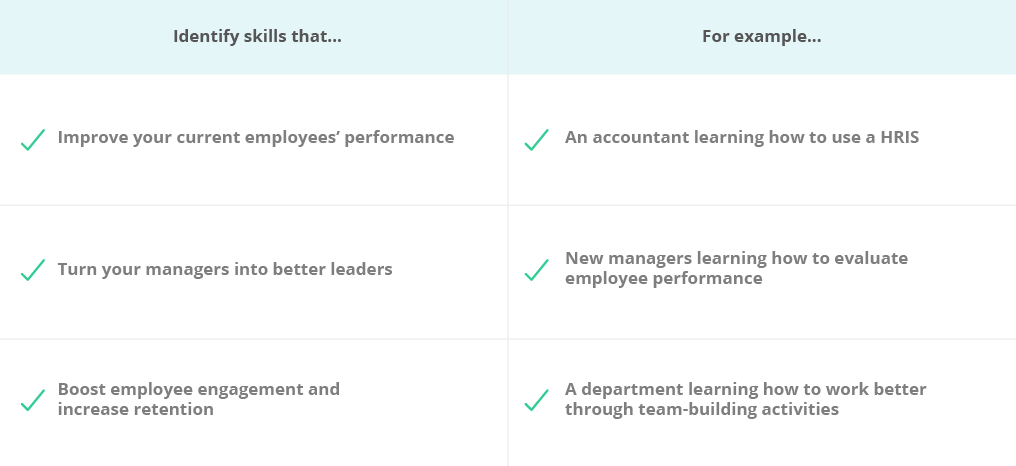
Once you’ve identified your needs and desired skills, begin planning your employee training program. Your program should aim to develop the skills you deem most important.
Set your objectives
Training just for the sake of it costs money and time. Define the goals of your programs before you commit. Ask yourself questions like:
-
How will employee performance improve after this program?
- For example, “Our accountants will learn how to use X tool to handle transactions faster.”
-
How will employees better achieve business goals after this program?
- For example, “Our sales team will use new negotiation skills to increase sales quotas by X% in Y months.”
-
How will this training program better prepare employees to take on managerial roles?
- For example, “X employee will be able to implement constructive performance reviews for his/her team.”
-
How will this program improve our employee retention rates?
- For example, “Our turnover rate next year will decrease by X% after we plan team-building activities that boost employee morale and retention.”
Include your employees
Ask your staff what they would like to learn more about, and get them involved in designing a training program. Employee training and development programs work best when employees shape them.
Before launching a program, ask employees:
-
What would make you feel more confident at work?
- A salesperson might say: “I would feel more confident at work if I participated in a sales role-playing exercise with a senior coworker for difficult sales scenarios.”
-
What learning methods work for you?
- Some people find live sessions more interesting, while others prefer training at their own pace through online courses.
-
What would improve your team’s performance?
- Some employees might want training on communication techniques and time-management methods.
-
What are your interests outside of work?
- The kinds of conferences employees like to attend or the books they like to read can provide insight into how to build better employee retention programs.
Types of employee training programs
Before you pick a training program, consider your options. Different training programs address varying needs, budgets and desirable outcomes. Here’s an overview of training program types to help you choose the most suitable one.
Internal vs. Outsourced
Decide whether you want to design internal training programs, or hire a professional company to help train your employees. There are benefits and drawbacks to both in-house and outsourced training program types:
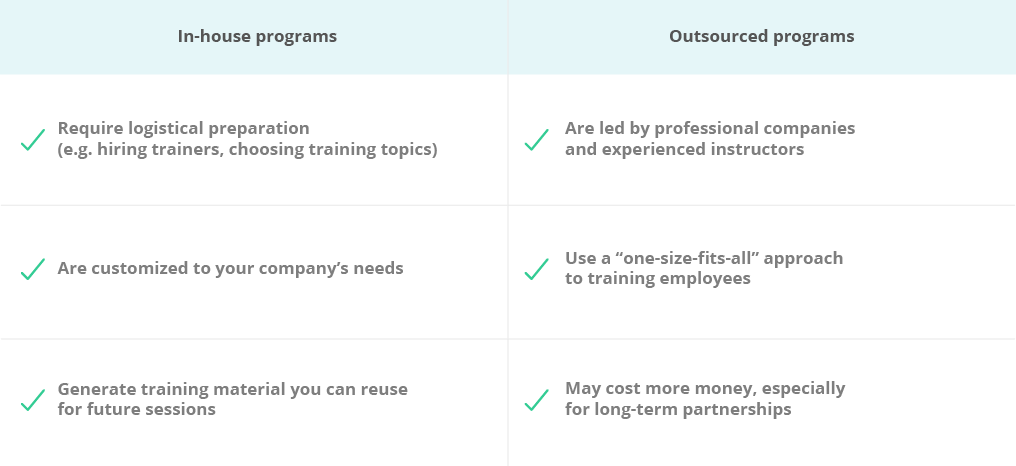
If you want to outsource your employees’ training, you could start by checking out these companies:
Classroom-style vs. Workshop-style
Classroom-style training works best for storytelling sessions and presentations. Host workshop-style programs for brainstorming, simulation and role-playing games. Here’s a breakdown of both classroom-style and workshop programs:

In-house seminars vs. Industry conferences
Train more employees at the same time by hosting an in-house seminar. Paying for industry conferences allows you to offer custom learning opportunities to your employees. Here’s an overview of the qualities of both training types:
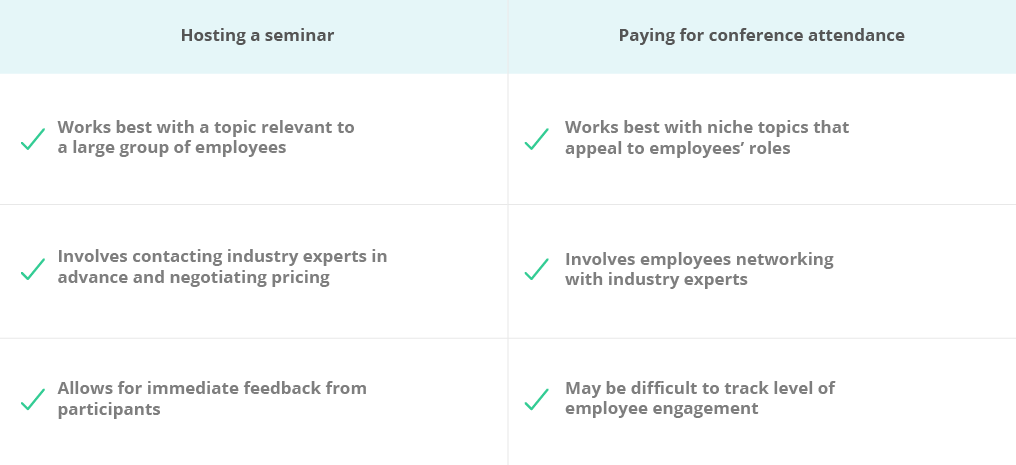
Individual vs. Group training
Group training will go a long way for departments that benefit from cross-team training, (e.g. communication skills training may benefit both sales and marketing teams.) Build individualized learning programs into your training plans to give employees more freedom to shape their own learning.
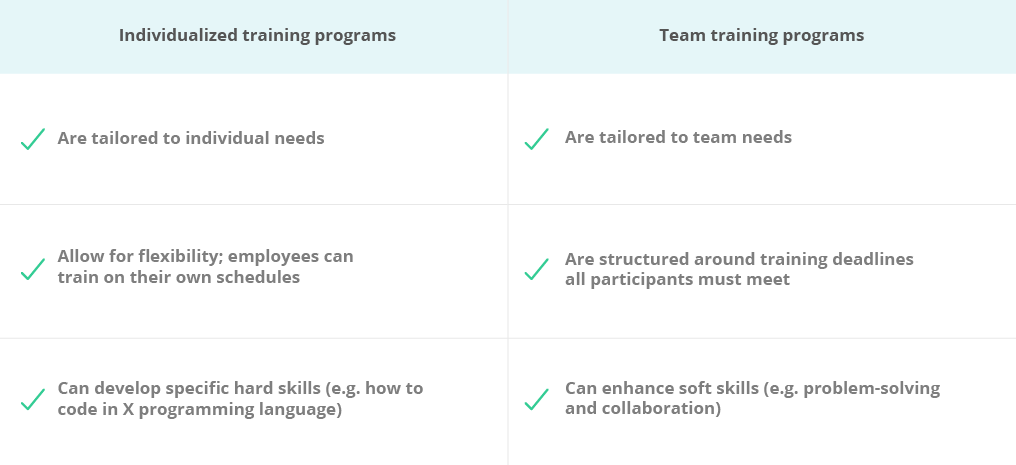
Skills-based training vs. Management training
Hone your skills-based training programs to help employees perform their every-day job duties better (e.g. technical training, like how to use Salesforce). Use management training to help individuals develop leadership qualities.
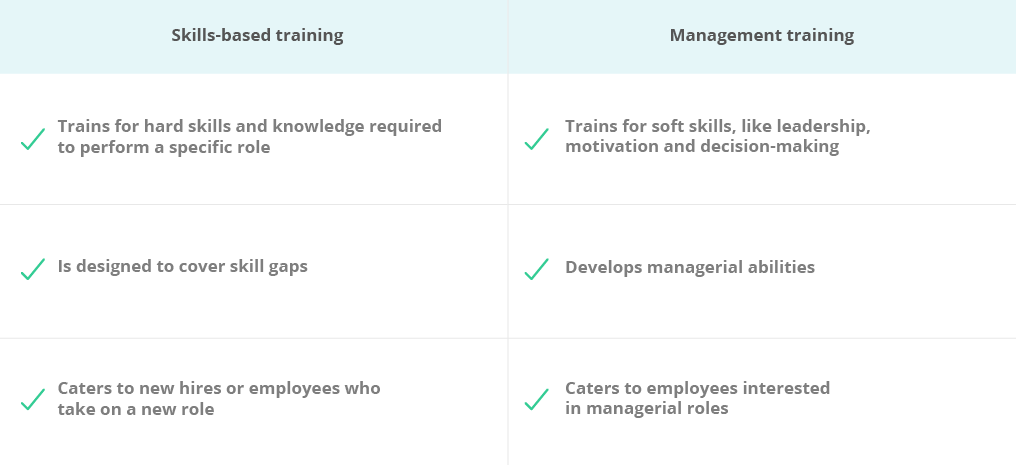
On-the-job training vs. External resources training
On-the-job training involves coaching and works well for new hires. You could also consider giving your employees access to educational resources (like physical or digital libraries and e-learning tools) which are easy to use and cost-effective.
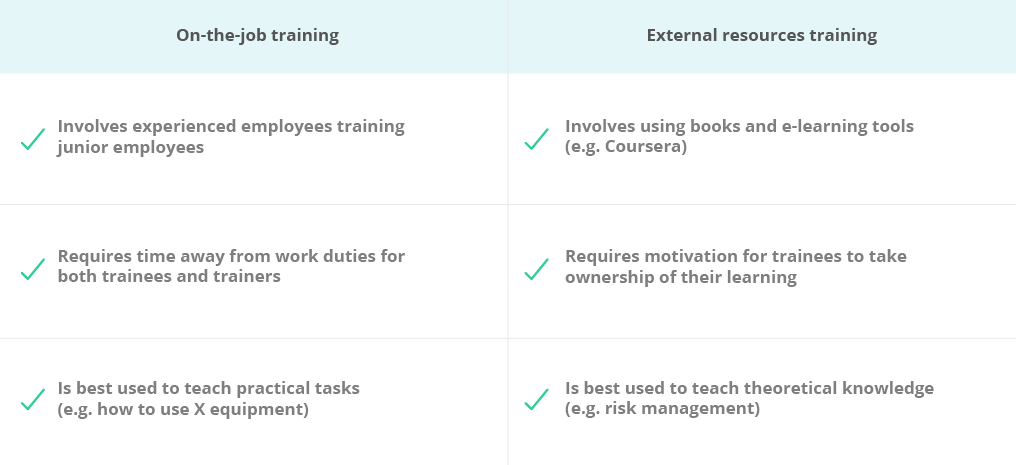
Other types of training that may apply to your organization include:
- Professional training, where employees are required to update their knowledge and/or get industry certifications. For example, accountants may obtain CPAs to advance their careers.
- Safety training, which aims to protect employees from accidents. For example, first aid, fire drills and hazardous materials training.
- Quality training, to certify workers conform to standards. For example, eliminating product flaws or complying with environmental laws.
Assess employee training programs
No training program is complete until you measure its results. Review and redesign your educational programs if they don’t meet your intended objectives. Use employee feedback to inform the process. Ask employees:
- What new (e.g. task, tool, skill) did you learn from the program?
- How will (or did) you apply this newly-acquired knowledge on the job?
- What did you like about the program and what should we improve (e.g. topic, methodology, instructor, material)?
Over time, you can gauge the effectiveness of your training programs by tracking improvements in employee performance.
Training programs work best in smaller, routine chunks, as opposed to one-time educational blips. Adopt a learning and development culture at your company to prompt all employees to seek personal and professional advancement.
Frequently asked questions
- What is the most common type of employee training?
- The most common type of employee training is orientation, a one-time event that formally welcomes and introduces new hires to the company during their first week.
- What does a good training program look like?
- A good training program has clear, achievable goals, consistency in training delivery, and is led by knowledgeable and enthusiastic trainers. It ensures the long-term success of the company.
- What is the purpose of a training program?
- The purpose of a training program is to equip employees with necessary skills and knowledge for their daily tasks, enhancing their experience and comfort in their roles.
- How can you assess the effectiveness of a training program?
- The effectiveness of a training program can be assessed by measuring improvements in employee performance over time and gathering feedback from employees about the program.
- What are the different types of employee training programs?
- Employee training programs can be internal or outsourced, classroom-style or workshop-style, in-house seminars or industry conferences, individual or group training, skills-based or management training, and on-the-job or external resources training.




